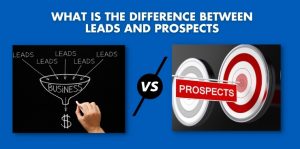Anyone working in sales has likely heard the terms “lead” and “prospect” at team meetings or on sales training calls. Sometimes the two terms are used interchangeably, which can lead to a certain amount of confusion. A lead is a lead, and a prospect is a prospect. They are dependent on each other, but they do not hold the same meaning or place in the sales process.
Leads often become prospects, but prospects do not convert to leads. To close more sales and increase revenue, every competent salesperson should understand the difference between leads and prospects. Moreover, they should understand how to market and sell to prospects correctly to bring in new business. Here are definitions for both terms in a sales process. We will also clarify how to determine when a lead has converted to a prospect. Additionally, we will examine some best practices for marketing to prospects that will earn the best ROI.
What Is The Difference Between Leads And Prospects?
To start, we need clear definitions of both a lead and a prospect:
Lead
A sales lead is anyone who has provided some basic information to be contacted via a lead generation campaign. It’s the initial step in any sales process or customer journey. Leads are interested in your product/service. But, at this phase, you don’t have specifics regarding actual needs or motivations. Usually, a member of the sales team will qualify leads. This job falls to the sales team because leads are collected to ensure a product or service is right for them. At this point in the process, provided your offerings are a proper fit, a lead is considered an SQL (Sales Qualified Lead). Contact is established, and the sales department begins to establish the context you need for a strong relationship. The added context, research and contact determine whether they will be considered a prospect.
Prospect
Prospects are leads that are now engaged in two-way communication with you. There is likely real potential for a buying decision in the near future.
Essentially, prospects are leads that have customer potential. They have greater potential for your sales team to establish a long-term relationship that is profitable for both parties. The key difference is that leads have requested more information or left contact information via a marketing channel. A prospect is a lead that has responded to further communication resulting from follow-up by your sales team.
How To Identify When a Lead Becomes A Prospect
When a lead has established two-way communication, your sales team can begin the process of further qualifying. The objective is to discover what their needs are and what solutions you can offer that will benefit them most. Most teams have at least one specific profile to help potential prospects easily identify and discuss their needs and objections.
These profiles typically include minimum annual revenue, business sector, and the number of employees. Before establishing two-way contact, sales will try to find the profile that best fits available lead information. Finally, sales and marketing will customize materials that address a lead’s expressed interest, actual needs and potential pain points or objections. Two-way communication is established, and sales can begin the process of converting the prospect from a potential buyer to a customer.
 Tips and Tricks for Better Prospect Marketing
Tips and Tricks for Better Prospect Marketing
The name of the game in prospect marketing is “reel in the catch”. To use an analogy, prospect marketing is like fishing. You’ve got a fish on the line and the hook is set; you are ready to start bringing your latest conquest toward the boat. Every aspect of your prospect marketing strategy should be directed toward drawing prospects deeper into your sales funnel to a buying decision. Here are some practical ways you can accomplish that objective:
Maintain a Consistent Prospecting Schedule
Following a consistent routine with prospecting is critical to your sales team’s success. It doesn’t matter if your reps spend 15 minutes a day or 15 hours a week prospecting, consistency is the most important factor.
Establishing consistency through a daily commitment improves your team’s qualifying skills and helps. Furthermore, they will identify more prospects from the leads currently at the top of the sales funnel. Some sales managers schedule prospecting time for the first part of the day since it tends to produce superior results.
Stay Focused
Encourage your team to eliminate all distractions while prospecting. The way to do this to establish a prospecting plan with an eye toward your business goals and sales objectives. Assign daily tasks to keep your reps on track, and include customer retention strategies on a daily basis.
In fact, you may want to allot specific days dedicated to strengthening relationships with existing customers. iIt cuts down on customer churn. It also has the potential to generate referral business in the process.
Vary Your Technique According to Prospect Profiles
Do not stick with the same marketing channel every day. Focus efforts on email one day a week, social media another, phone calls the next, and continue varying your efforts. Changing up your approach every day will help you understand how your prospects want to engage with your sales team. The more varied your efforts, the greater the likelihood that you will connect with more prospects.
Don’t be Afraid to Script
It is an often overlooked fact that the most effective salespeople use scripts. Personalization is important too, but using scripting and personalization for every interaction is a killer combination that is tough to beat. The script gives you a sound footing to cover all your qualifying questions. Personalization creates the connection you need to establish a relationship and close the sale.
Begin by writing a script that will fully qualify any sales lead. Next, do your homework on each qualified sales lead before prospecting so you can personalize effectively. Finally, combine your script with your prospect research findings and make your first contact. Your presentation and sales skills will do the rest. It is rare a sales rep does not close a deal with effective research and scripting.
 Be the Provider of Ultimate Solutions
Be the Provider of Ultimate Solutions
When you make contact with a potential prospect, always set yourself up as the provider of solutions to their problems. Your prospect research should already have identified their needs and pain points. So, all that remains is to present enticing solutions and overcome their objections.
Approaching the sales process from a service standpoint is critical to this practice. Ask your prospects how you help them resolve persistent problems. Part of the qualifying process involves addressing existing concerns and issues. So, this should be a natural part of the process anyway.
Starting contact with the mindset that you have all the answers and an easy, affordable solution for everything is crucial. Your attitude makes the difference between “I’ll get back to you” and “Where do I sign?”.
Warm-Calling Works
You only get one chance to make a first impression, and this is true in both business and private life. Soft launching that first impression, however, is an excellent way to improve your chances of success in sales. This technique, referred to as warm-calling, involves putting yourself on a prospect’s radar before the first contact.
Generally, sales reps working warm-calling provide information about who they are and how they can help via email or instant message. This pre-contact introduction can help put prospects at ease and be more receptive to a meeting or sales call. Additionally, connecting or sharing content via social media is another opportunity to warm call prospects. Liking/sharing their posts or connecting via LinkedIn are both excellent methods of warm-calling, and they are non-invasive. Give this method a try, and see if your closing rate improves.
Show Prospects You are a Thought Leader
Marketing content should be focused on establishing your brand as a thought leader in your industry. It is not solely about SEO or increasing your search rank. It is about positioning yourself as an innovator with solutions. Providing high-quality content targeted at your prospects’ custom profiles is key to successful prospect marketing. Focus on quality over quantity. Engage people within your own organization to showcase how your products and services can give any company a competitive edge.
Know the Difference Between Prospecting and Selling
It is important to never forget that prospecting is not selling. Prospecting is about finding and connecting with qualified sales leads and then building a relationship with your most promising prospects. Pushing sales and marketing materials down their throat at every opportunity is going to shut down your process fast.
Maintain your focus on providing solutions as an industry innovator and thought leader. Prospects know when you are showing genuine interest in helping them build a better, stronger business. Don’t hamstring your efforts before you get your sales off the ground. Be attentive, ask the right questions, and listen to prospects’ answers with genuine interest. Anything less is simply wasted effort.
Final Thoughts
Turning a lead into a prospect means effectively qualifying to establish a strong relationship from the first contact. Establishing a basic qualifying script and researching your leads before the first contact provides a strong foundation of lead conversion. Moreover, if you want to develop effective prospect marketing, you will need to focus on relationships over closing rate. It may take more time than simply blasting marketing material and seeing what sticks, but slow growth is stable growth. Market your business to prospects as an innovative solutions provider, and you will see soon see your sales revenue and business growth.
Do you need more effective prospect marketing? Contact us today to learn more about building stable growth through effective prospecting.



 Tips and Tricks for Better Prospect Marketing
Tips and Tricks for Better Prospect Marketing Be the Provider of Ultimate Solutions
Be the Provider of Ultimate Solutions